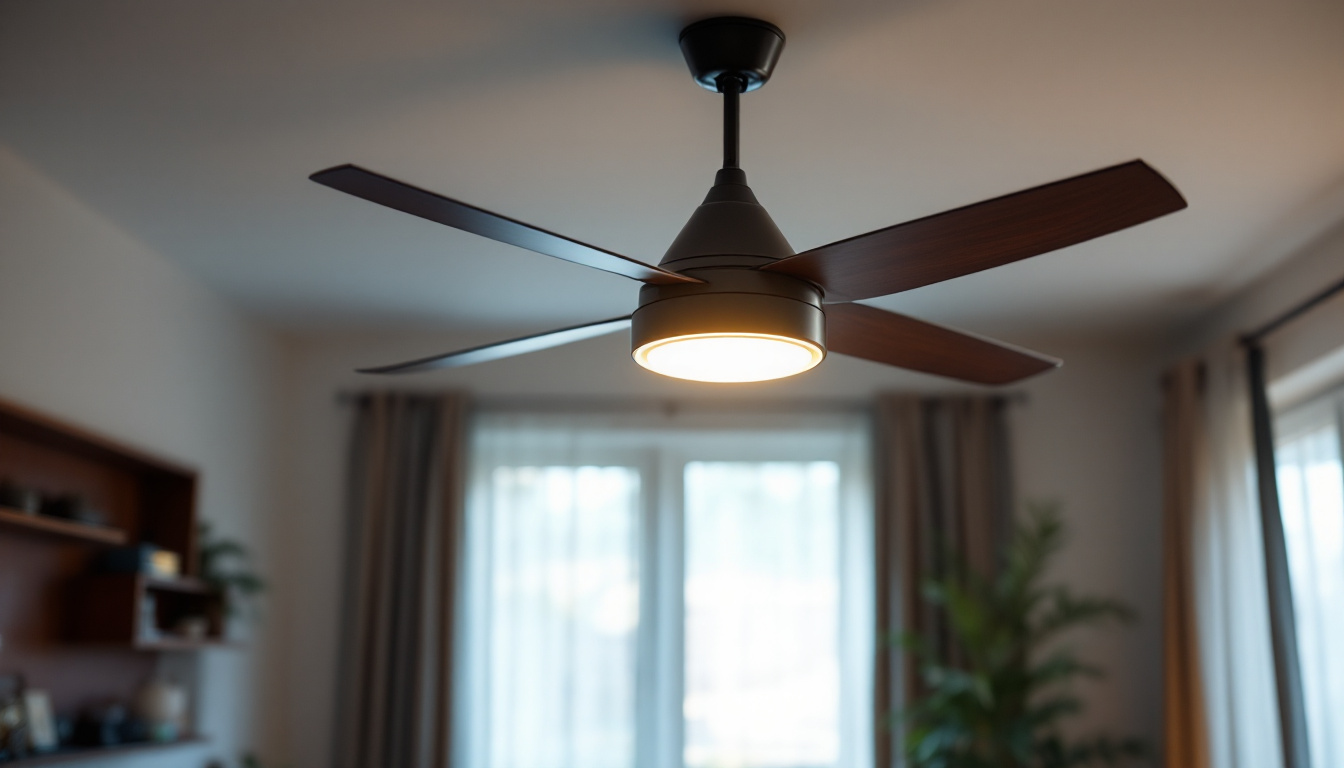
As lighting professionals, understanding the intricacies of ceiling fan light fixtures is crucial for delivering quality service and ensuring customer satisfaction. This essential checklist serves as a comprehensive guide to help contractors navigate the complexities of ceiling fan installations, from selecting the right fixtures to ensuring proper installation and maintenance.
Ceiling fan light fixtures are not just functional; they also play a significant role in the aesthetic appeal of a room. These fixtures come in a variety of designs, styles, and functionalities, making it essential for lighting professionals to stay informed about the latest trends and technologies. This section explores the fundamental aspects of ceiling fan light fixtures that every contractor should know.
Ceiling fan light fixtures can be broadly categorized into several types, each serving different purposes and preferences. The most common types include integrated light kits, downlight kits, and pendant light fixtures. Integrated light kits are built directly into the fan, providing a seamless look while maximizing space. Downlight kits, on the other hand, offer focused illumination, ideal for task lighting. Pendant light fixtures add a stylish touch and can serve as a statement piece in any room.
Understanding these types allows lighting professionals to recommend the best option for their clients based on the room’s design, functionality, and personal preferences. Additionally, being aware of the latest innovations in ceiling fan light fixtures can enhance a contractor’s ability to provide tailored solutions. For instance, some modern ceiling fans now feature adjustable light brightness and color temperature settings, allowing homeowners to customize their ambiance according to the time of day or occasion. This versatility not only enhances the overall aesthetic but also improves the usability of the space, making it more inviting and functional.
With a growing emphasis on energy efficiency and sustainability, lighting professionals must consider the energy consumption of ceiling fan light fixtures. LED bulbs are a popular choice due to their longevity and low energy usage. When selecting fixtures, contractors should prioritize those that are compatible with LED technology, as this not only benefits the environment but also reduces energy costs for clients.
Furthermore, many manufacturers are now producing ceiling fan light fixtures that are designed with energy efficiency in mind. These fixtures often come with features such as dimmable options and smart technology integration, allowing users to control their lighting remotely. By staying informed about these advancements, lighting professionals can offer clients modern solutions that align with their sustainability goals. Additionally, the integration of smart home technology into ceiling fan light fixtures is becoming increasingly common. Features like voice control compatibility and programmable settings enable homeowners to optimize their lighting and fan usage based on their daily routines, further enhancing energy savings and convenience. As the demand for smart home solutions continues to rise, contractors who are knowledgeable about these features will be better positioned to meet client expectations and provide exceptional service.
The installation of ceiling fan light fixtures requires careful planning and execution. Proper installation ensures safety, functionality, and longevity of the fixtures. This section outlines key considerations that lighting professionals should keep in mind during the installation process.
Before beginning any installation, it is essential to assess the electrical requirements of the ceiling fan light fixture. Contractors should verify that the existing wiring can support the new fixture, taking into account the wattage and amperage. Additionally, understanding local electrical codes and regulations is crucial to ensure compliance and safety.
In some cases, it may be necessary to upgrade the electrical system to accommodate the new fixture. This could involve installing a dedicated circuit or ensuring that the ceiling box is rated for the weight of the fan and light combination. By addressing these electrical considerations upfront, contractors can avoid potential issues down the line.
Ceiling fan light fixtures can be mounted in various ways, depending on the design of the fan and the layout of the room. Common mounting options include flush mount, downrod mount, and angled mount. Each option has its advantages and is suited for different ceiling heights and room configurations.
Flush mount fixtures are ideal for rooms with low ceilings, providing a sleek look while maximizing headroom. Downrod mounts are better suited for higher ceilings, allowing for optimal airflow and light distribution. Angled mounts are necessary for sloped ceilings, ensuring that the fan operates efficiently. Understanding these mounting options enables lighting professionals to make informed recommendations to clients, ensuring both aesthetic appeal and functionality.
Dust and debris can accumulate on ceiling fan light fixtures, affecting both their appearance and functionality. Lighting professionals should recommend regular cleaning schedules to clients, emphasizing the importance of using appropriate cleaning materials. Soft cloths and gentle cleaning solutions are ideal for maintaining the integrity of the fixtures without causing damage.
Additionally, contractors should advise clients to check for loose bulbs or connections periodically. Ensuring that all components are secure can prevent flickering lights and potential electrical hazards. By providing clients with maintenance tips, lighting professionals can enhance customer satisfaction and prolong the life of the fixtures.
Despite proper installation and maintenance, ceiling fan light fixtures may encounter issues over time. Common problems include flickering lights, buzzing noises, or the fan not operating correctly. Lighting professionals should be equipped with troubleshooting techniques to address these issues effectively.
For flickering lights, contractors may suggest checking the bulb connections or replacing the bulbs with compatible options. Buzzing noises can often be resolved by ensuring that the fixture is securely mounted and that the fan blades are balanced. If the fan is not operating, it may be necessary to inspect the wiring and remote control settings. By offering troubleshooting guidance, lighting professionals can build trust and credibility with their clients.
Selecting the appropriate ceiling fan light fixtures for various spaces is a critical skill for lighting professionals. Different rooms have unique lighting needs and aesthetic considerations. This section provides insights into choosing the right fixtures for specific environments.
In living rooms and family areas, ceiling fan light fixtures should provide ample illumination while creating a warm and inviting atmosphere. Contractors should consider fixtures that offer adjustable brightness and color temperature options, allowing clients to customize their lighting based on the time of day or activity.
Additionally, selecting fixtures that complement the room’s decor is essential. Whether the style is modern, traditional, or eclectic, the right fixture can enhance the overall aesthetic. Lighting professionals should encourage clients to consider the scale and proportion of the fixture in relation to the room size to achieve a harmonious look.
In bedrooms and relaxation spaces, the focus should be on creating a calming ambiance. Ceiling fan light fixtures with dimmable features are ideal for these areas, allowing for softer lighting during the evening hours. Warm-toned bulbs can further enhance the cozy atmosphere.
Moreover, incorporating ceiling fans with integrated light kits can save space and provide a streamlined look. Lighting professionals should also discuss the importance of positioning the fixture to avoid direct glare, ensuring a comfortable environment for reading or unwinding.
The lighting industry is continually evolving, with new technologies enhancing the functionality and appeal of ceiling fan light fixtures. Staying updated on these innovations is vital for lighting professionals looking to provide cutting-edge solutions to their clients.
Smart lighting technology has transformed the way homeowners interact with their lighting systems. Many ceiling fan light fixtures now come equipped with smart capabilities, allowing users to control their lights through smartphone apps or voice commands. This integration offers convenience and flexibility, enabling clients to adjust their lighting settings from anywhere.
Lighting professionals should familiarize themselves with various smart lighting systems and their compatibility with ceiling fan fixtures. Educating clients about the benefits of smart technology can enhance their overall experience and satisfaction with their lighting solutions.
Adaptive lighting solutions are gaining popularity, particularly in residential settings. These systems adjust the brightness and color temperature of the lights based on the time of day or the activities being performed. For example, cooler tones may be used during the day to enhance focus, while warmer tones can create a relaxing atmosphere in the evening.
By offering adaptive lighting solutions, lighting professionals can provide clients with a dynamic and personalized lighting experience. Understanding the technology behind these systems and how to implement them in ceiling fan light fixtures is essential for staying competitive in the industry.
Ceiling fan light fixtures are an integral part of modern lighting design, combining functionality with aesthetic appeal. For lighting professionals, mastering the essential checklist outlined in this article is crucial for delivering exceptional service and meeting client expectations. From understanding the various types of fixtures to ensuring proper installation and maintenance, each aspect plays a significant role in the overall success of a project.
By staying informed about the latest trends, technologies, and best practices, lighting contractors can position themselves as experts in their field. This knowledge not only enhances their credibility but also fosters long-term relationships with clients, ultimately leading to successful and satisfying lighting solutions.
Ready to elevate your lighting projects with the finest ceiling fan light fixtures on the market? Look no further than LumenWholesale, where we provide lighting professionals like you with top-tier, spec-grade lighting products at unparalleled wholesale prices. Say goodbye to local distributor markups and hello to our extensive selection that meets rigorous industry standards. Plus, with free shipping on bulk orders, you can enjoy premium lighting solutions at the best value — all without hidden fees or compromises. Don’t miss out on the perfect combination of quality, affordability, and convenience. Visit LumenWholesale today and discover the best in wholesale lighting for your next project.

Discover the evolution of lighting technology as we delve into the history of fluorescent and LED light bulbs.

Discover why sourcing ceiling lights in bulk from local distributors might not be your best bet.

Discover how gooseneck light fixtures can transform your lighting projects with their unique blend of style and functionality.

Discover why lighting contractors should prioritize clearance sales to boost their business.